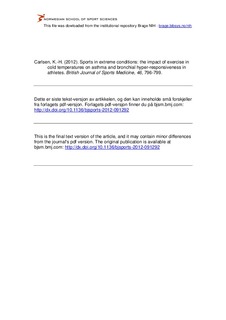| dc.contributor.author | Carlsen, Kai-Håkon | |
| dc.date.accessioned | 2013-04-11T06:18:22Z | |
| dc.date.available | 2013-04-11T06:18:22Z | |
| dc.date.issued | 2012 | |
| dc.identifier | Seksjon for idrettsmedisinske fag / Department of Sports Medicine | |
| dc.identifier.citation | British Journal of Sports Medicine. 2012, 46, 796-799 | no_NO |
| dc.identifier.issn | 1473-0480 | |
| dc.identifier.uri | http://hdl.handle.net/11250/171128 | |
| dc.description | I Brage finner du siste tekst-versjon av artikkelen, og den kan inneholde ubetydelige forskjeller fra forlagets pdf-versjon. Forlagets pdf-versjon finner du på bjsm.bmj.com: http://dx.doi.org/10.1136/bjsports-2012-091292 / In Brage you'll find the final text version of the article, and it may contain insignificant differences from the journal's pdf version. The definitive version is available at bjsm.bmj.com: http://dx.doi.org/10.1136/bjsports-2012-091292 | no_NO |
| dc.description.abstract | Exercise-induced asthma (EIA) and bronchial hyper-responsiveness (BHR) are frequently reported among elite athletes of outdoor endurance winter sports, particularly in cross-country and biathlon skiers. The pathogenesis of EIA is related to water loss and heat-loss through the increased respiration during exercise, leading to mediator release, airways inflammation and increased parasympathetic nervous activity in the airways, causing bronchial constriction and BHR. In the competing elite athlete this is presently considered to be due to the frequently repeated increased ventilation during training and competitions in combination with the repeated environmental exposure to cold air in outdoor winter sports. It is important that athletes at risk of asthma and BHR are monitored through regular medical control with assessment of lung function and BHR, and when BHR or asthma is diagnosed, optimal controlling treatment through anti-inflammatory treatment by inhaled steroids should be started and relieving treatment (inhaled ipratropium bromide and inhaled β2-agonists) should be used to relieve bronchial constriction if present. | no_NO |
| dc.language.iso | eng | no_NO |
| dc.publisher | BMJ Group | no_NO |
| dc.subject | air | no_NO |
| dc.subject | asthma, exercise-induced / prevention and control | no_NO |
| dc.subject | bronchial hyperreactivity | no_NO |
| dc.subject | bronchoconstriction | no_NO |
| dc.subject | cold temperature / adverse effects | no_NO |
| dc.subject | exercise | no_NO |
| dc.subject | humidity / adverse effects | no_NO |
| dc.title | Sports in extreme conditions: the impact of exercise in cold temperatures on asthma and bronchial hyper-responsiveness in athletes | no_NO |
| dc.type | Journal article | no_NO |
| dc.type | Peer reviewed | no_NO |
| dc.subject.nsi | VDP::Social science: 200::Social science in sports: 330::Other subjects within physical education: 339 | no_NO |
| dc.source.journal | British Journal of Sports Medicine | |
| dc.identifier.doi | 10.1136/bjsports-2012-091292 | |
